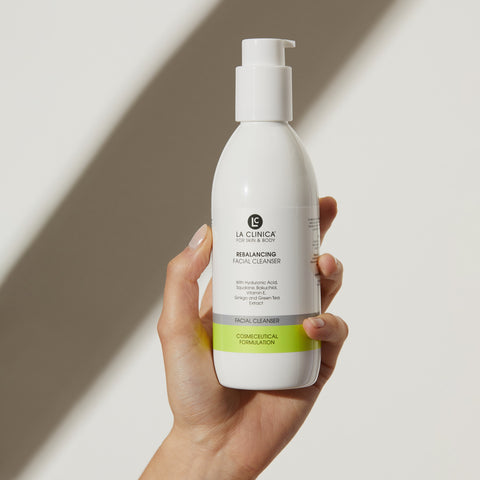0 item in bag
By checking out, I agree to the Terms & Conditions and acknowledge that I have read the Privacy Policy. Shipping and promotions calculated in checkout.

Working in skincare sure has its benefits; having access to a huge array of products, learning all kinds of skincare ingredients and trialling anything and everything.
My skin is normally incredibly resilient and handles most things thrown its way, which is lucky in this position. But the hormonal ups and downs of pregnancy and now 7 months postpartum means it has been a little bit less tolerant of my irregular, active-filled routine. Cue: damaged skin barrier.
It happens to the best of us, but definitely isn’t a nice experience to go through. Itchy, irritated, lumpy skin and redness to boot. Time to put all my skincare knowledge to good use, here’s exactly how I repaired my skin barrier postpartum.

Before delving into my personal journey, let's take a moment to understand the skin barrier's significance.
The skin barrier, also known as the stratum corneum, is the outermost layer of our skin. It serves as a protective shield, guarding us against environmental aggressors, retaining moisture, and keeping our skin healthy and radiant. Rather important stuff.
The skin barrier consists of lipids, including ceramides, cholesterol, and fatty acids, which form a protective barrier against external stressors like pollution, UV rays, and bacteria. It also prevents excessive moisture loss, keeping our skin hydrated and supple. So you see why it is such an important thing to keep tabs of.
Keep reading: The Do's and Don’ts of Skin Barrier Repair
Back to my damaged skin barrier story. I should have noticed something was up when I applied my skincare and felt a tingling sensation all over my face. But being super busy entertaining a very active bub and equally active dog, I only first realised something was wrong when the areas around my nose started feeling irritated and itchy. Following this, my forehead began feeling textured and rough and finally I developed tiny whiteheads all around my chin and mouth area. All over, my skin felt tight and super dry - unmissable at this stage!

While this was my experience, a damaged skin barrier can manifest in various ways, including:
Now, let's dive into my journey of repairing a damaged skin barrier:

The first step in healing my skin barrier was reevaluating my routine. I switched out all my active skincare to give my skin a break and used only gentle, hydrating products free from any strong ingredients. For example, products I removed were - strong Vitamin Cs, exfoliating scrubs and Glycolic Acid. I will return to these once I am 100% sure my skin barrier is back to its usual self again.
Ceramides are the building blocks of a healthy skin barrier. I opted for a moisturiser rich in ceramides, which helped replenish and strengthen my skin's protective layer. This moisturiser not only hydrated my skin but also improved its ability to retain moisture.
Niacinamide, also known as vitamin B3, is a powerhouse ingredient for repairing the skin barrier. I chose products containing niacinamide to include into my daily routine. This antioxidant not only aids in barrier repair but also helps reduce redness and improve overall skin texture.
Keep Reading: All You Need to Know About Niacinamide
Protection against UV rays is crucial when repairing a damaged skin barrier. UV damage can further weaken the skin barrier, so I chose a broad-spectrum SPF 50+ sunscreen to shield my skin from harmful rays.
Repairing a damaged skin barrier takes time and consistency. I stuck to my routine diligently, resisting the temptation to switch products frequently or re-introduce actives too soon. It's essential to allow your skin the time it needs to heal.
Cleanse morning & night with a gentle cream cleanser. I chose the Rebalancing Cleanser because I love the smell, but the Sensitive Skin Cleanser is another great choice.
Shop Rebalancing Cleanser

Our MEGA Hyaluronic Acid Serum. Specially designed to support the skin barrier by hydrating, soothing, reducing inflammation and supporting the healing process. Soft and gentle on the skin, you can almost feel the healing take place as it soaks in.
Shop Essentials Hydrating and Healing Serum

A buttery soft, deeply hydrating skin barrier cream. Formulated for hydration, skin-nourishment and skin barrier fortification as the primary focus. Full of amazing skin barrier ingredients such as Niacinamide, Ceramides, Cholesterol and Oils rich in essential fatty acids.
Shop Essentials Deep Hydration Moisture Cream

Always protect skin from the sun! I made sunscreen a non-negotiable step in my morning routine - which it always is anyway but just to remind those who might forget 😉

Over time, my efforts to repair my skin barrier paid off. My skin gradually regained its natural moisture balance, became less sensitive, and felt smoother and more radiant. The redness and irritation began to subside, and so did the breakouts. It took about 2 weeks for my skin to get back to its usual self, but as all skin is different, results may vary.
Repairing a damaged skin barrier is a journey that requires patience and the right products. It's essential to listen to your skin, make gentle choices, and prioritise consistent care. While my journey to repair my skin barrier may not be identical to yours, these steps can serve as a guide to help you embark on your own path to healthier, more resilient skin.
Keep reading: 9 Best Ingredients for your Skin Barrier